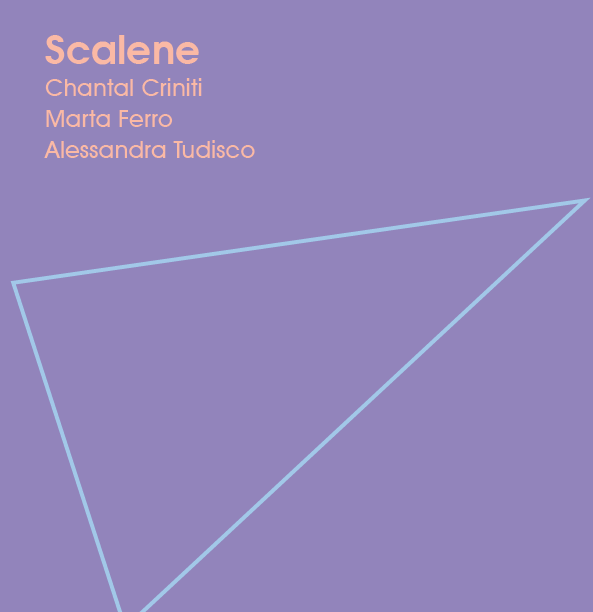
Scalene
Chantal Criniti | Marta Ferro | Alessandra Tudisco
questions asked by Stefania Galegati
through February 11, 2023
Scalene:
In geometry: (of a triangle, or of a non-isosceles trapezoid) having all sides unequal in length.
In anatomy: of or relating to the scalenus muscles (anterior, middle and posterior), inner muscles of the lateral region of the neck that, depending on their disposition, raise the ribs or incline the neck to one side or stiffen it.
A triangle made with two hands, joining the tips of the index fingers and opposing those of the thumbs. A void in the middle.
Three different trajectories united in the practice of painting.
SG_ You tell us stories and then continually deny the tale. What happens in that denial, or that void, or that hiding?
CC_ That void [or that denial, or that hiding] is a form of possibility. A space that extends beyond contingency to cradle the memory of the world, its desires. In that space, emotions and perceptions do not always leave visible traces in experience but guide it from deep within. It is a form of connective tissue that weaves, complex and organic, beneath what we concretely perceive: a subterranean fabric that calls us back to our own ontological indeterminacy, beyond reach of the senses yet intuited through the heart. That void [or that denial, or that hiding] is an invitation to pry bare-handed beneath the surface of things.
SG_ Is there anything that frightens you as you draw? Or, in any case, tell me about your need to draw. Is it the need that it seems to be, an extension of your body?
MF_ It’s not a question of fear, but rather of an open-ended search out of which unpredictable and uncertain trajectories often emerge, over which I never have total control. When I work, I follow a tactile rhythm in which improvisation, fascination and linear desire converge in a single action. In drawing, I don’t search for the purely anatomical aspect of the body. What concerns me is its volumetric structure, the poses that it can adopt and the attitudes that arise out of them; the timbres and meanings that the body can express. This translates into overlapping strokes and masses that convey the emotional lens through I observe the human form. A series of interwoven marks, of gears that sometimes mesh and sometimes do not. At first I trail behind them, but I duly succeed in taking command, creating – in a state of pure aesthetic delight – volumes and bodies that I understand as my own, which recall my own thoughts and experiences.
SG_ Your all-too-apparent way of mistreating your work – of always working on lightweight paper, boxes, domestic fabric – and also the fact that you have become increasingly incorporeal, using games, relationships, questions. Are these causes or consequences?
AT_ They’re causes, because when I bring something into the world, I want it to be close to the viewer in affective terms. I don’t want to produce distance. These are not precious objects that belong to some sort of elsewhere, they are objects vulnerable to affect, and therefore to wear and time. They live in continuity with the world. I don’t treat my work any differently from the other objects in my home, and I don’t expect anyone else to do so. Handling something with care means being aware that it might break, deteriorate, change.
But it is also a consequence, because this desire for nearness is reflected in the way I work. I don’t look far off to bring an object into the world, I look close; I look into my own core. A nightgown is much more immediate than a length of jute, when the question is what allows the greatest immediacy. A scrap of torn foolscap is always ready to hand, but the same cannot be said of pure cotton watercolour paper.
I want to evoke the familiar, to reduce the distance between the internal and the external, between the microscopic and the macroscopic, between myself and the other; I want to reach great distances by standing firmly in the now.
So, to answer you in full, all this – all my way of doing things – is a consequence of having been a lodestone child who wanted the world to come to her. It became a cause when I began to move as well.